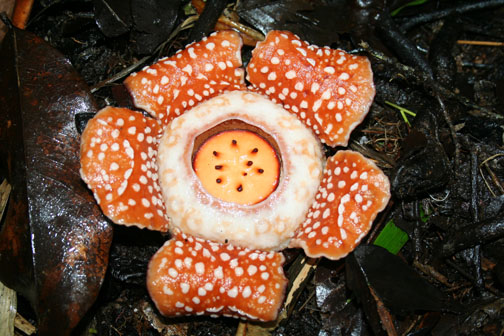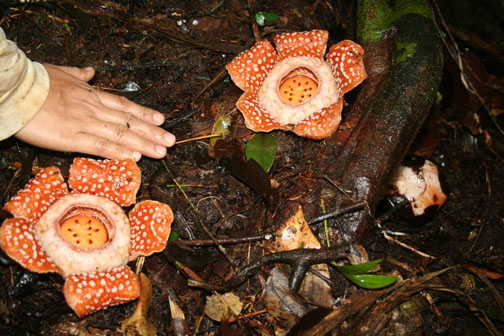Species named after the city of Manila, Philippines.
Because the taxonomic history of R. manillana is intertwined with other taxa, the text shown on the R. lagascae page is repeated here.In 2007, two independent teams of scientists visted Samar, studied the Rafflesia present there, and both determined that this taxon was distinct from the taxon known as R. manillana of Luzon. This difference prompted Madulid et al. (2008) to name the Luzon taxon R. panchoana. Barcelona et al. (2009) clearly showed how both R. banahawensis and R. banahaw corresponded to the description of the taxon named R. philippensis by Blanco, thus R. philippensis is the earliest and therefore valid name for the taxon. In 2013, Pelser et al. reported finding a species distinct from R. philippensis at the foot of Mt. Banahaw. This taxon corresponded to the description of R. lagascae in Blanco (1845). Because this is the earliest name, the taxon previously called R. manillana that is widespread on Luzon should be called R. lagascae. And because the type collection for R. manillana is from Samar, and this taxon is distinct from R. lagascae, that name should apply only to the Samar populations. Given that R. lagascae is the most widespread of all the Philippine Rafflesia species, it has been cited in essentially all publications prior to 2013 as R. manillana. The neotype for R. lagascae is now Barcelona 3819 (CHR). Morphological differences between R. manillana and R. lagascae, such as the diaphragm color and width of the diaphragm opening, are discussed in Madulid et al. (2008) and Barcelona et al. (2009).
Literature CitedBarcelona, J.F., P.B Pelser, D.S. Balete, and L.L. Co. 2009. Taxonomy, ecology, and conservation status of Philippine Rafflesia (Rafflesiaceae). Blumea 54: 77-93.
Blanco F.M. 1845. Flora de Filipinas, 2nd. edition. Manila: M. Sanchez.
Madulid D.A., Villariba-Tolentino C., Agoo E.M.G. 2007 [2006]. Rafflesia banahawensis (Rafflesiaceae), a new species from Luzon, Philippines. Philippine Scientist 43: 43-51.
Madulid, D. A. and E. M. G. Agoo. 2008 [2007]. On the identity of Rafflesia manillana Teschem. (Rafflesiaceae). Philippine Scientist 44: 57-70.Madulid D.A., Buot I.E., Agoo E.M.G. 2008 [2007]. Rafflesia panchoana (Rafflesiaceae), a new species from Luzon Island, Philippines. Acta Manilana 55: 43-47.
Pelser P.B., Nickrent D.L., Callado J.R.C., Barcelona J.F. 2013. Mt. Banahaw reveals: The resurrection and neotypification of the name Rafflesia lagascae (Rafflesiaceae) and clues to the dispersal of Rafflesia seeds. Phytotaxa 131: 35–40.
Yahya AF, Hyun JO, Lee JH, Choi TB, Sun BY, Lapitan PG. 2010. Distribution pattern, reproductive biology, cytotaxonomic study and conservation of Rafflesia manillana in Mt. Makiling, Laguna, Philippines. Journal of Tropical Forest Science 22: 118–126.

